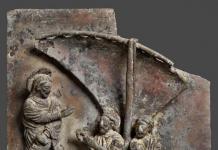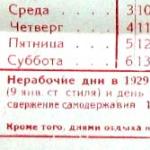If earlier rosaries were exclusively a prayer attribute, now they can also act as a fashion accessory. Interestingly, rosaries are found in different religions. They may differ in materials, number of beads, appearance, finishing, but they are used in the same way - they are sorted out when reading prayers. They have a simple shape and design, so making rosary beads with your own hands is not difficult.
Classic rosaries look like beads made of round beads, but there are also examples with oval, square and flat beads. You can make rosary beads for yourself - they are great for calming and allowing you to concentrate, or you can also make them for a gift, in which case it will be unusual and exclusive. If you make rosaries using natural stones, they can act as a talisman. Only in this case it is necessary to choose a stone for beads from among those that suit your horoscope.
In this article we offer several options for making rosary beads from different materials.
Wooden rosary
To make them you will need: a wooden blank, stain and varnish, fishing line, a small drill, a needle, sanding paper.

Rosary with knots
These rosaries can be made from different beads. Wood is considered the best material, but other beads are also suitable. All beads must have a central hole for threading through. For these rosaries you need one larger bead, it will be the main one. To make it stand out, you can take it in a different shape or from a different material. The dimensions of the rosary beads are not important, but beads with a diameter of 7 mm are considered the most convenient.

Bread rosary
For these rosaries, an unconventional material is used - bread. To prepare them you will need bread, sugar and sleight of hand. It is better to take white bread from second or third grade wheat flour, and only the crumb is used.
 There are two ways to make beads for rosaries.
There are two ways to make beads for rosaries.
First way. The bread crumb with added sugar is kneaded in your hands. Sugar is added to prevent the beads from cracking. Moreover, the higher the quality of the bread, the more sugar there should be. It takes a long time to knead the crumb, at least an hour. After this, it becomes like plasticine. Some people think that water can be added to make the bread mass more plastic, but this is not true; water will only reduce the strength of the product. When the bread mass becomes plastic and it can be easily molded into various products, you can begin to form round beads. You can make beads of other shapes, and if you add dyes to the bread crumb, you can get colored beads.
Second way. This method allows you to obtain more durable products. Sugar is added to the bread crumb, and then the mixture is brewed with boiling water. The mixture is left in a warm place so that it begins to sour, and then the crumb is rubbed through cheesecloth. The resulting mass should dry a little. At the same time, it must be stirred periodically so that it becomes similar to plasticine. After this, you can sculpt products from the bread mass. Since the mass is highly durable, the central hole in the rosary beads must be made immediately, before they dry. When stringing rosaries, you need to choose their length individually so that it is approximately the length of your palm.
Bread is one of the main building materials for a prisoner. It is used to make blowguns, games (backgammon, chess, checkers, dice), rosary beads, shelves, ashtrays, coasters, and glue.
They usually use white (wheat) bread of low quality, made from second or third grade flour. Although, in a pinch, rye may be suitable. The worst is light and soft bread made with artificial fluffers.
There are two ways to make various crafts from bread - fast, but of lower quality, and slow, but reliable.
With the quick method, the bread crumb is kneaded in your hands like plasticine. To prevent the bread from cracking when it dries, sugar is added to it. The higher quality the bread, the more sugar you need. Exactly how much is determined experimentally. In general, the more, the better. In any case, kneading will take at least one to two hours until the sugar crystals dissolve and the bread itself turns into a homogeneous mass like plasticine. Then any figures are made from it - from dice to ashtrays and figurines, or such chess pieces, as in the photo. Then left to dry. If you dry it quickly - on heating radiators or in the sun - then, most likely, cracks will appear. If necessary, dye is added to the mixture. Most often it is ashes from paper burned to produce black color. For other colors, you can use ballpoint pen paste.
If there is no sugar, then kneading the bread crumb will take much longer - 5-6 hours. At the same time, it is gradually moistened by the sweat of your hands; you can add a little saliva. No need to add water.
To obtain the highest quality and hardest products, use the second method: the bread crumb is poured (preferably immediately with sugar) with a small amount of boiling water and left for several hours. Ideally, this mass is left in a warm place for a couple of days - until the bread begins to sour, as evidenced by the characteristic sour smell that appears. This is for the most durable products. The mass prepared in this way is then ground - two people stretch a piece of fabric, a third lays out the semi-finished product and rubs it through it with a spoon. The dry residue is collected and discarded, and the pureed liquid mass is collected and laid out on cellophane to dry. Periodically knead and turn over. When it reaches the consistency of plasticine, everything that is needed is collected and molded. This is exactly the method used to make the famous Zekov bread rosary. While the made beads are still soft enough, they are pierced with a needle and strung on a rope, periodically then running back and forth along it until they are completely dry. Such rosaries, also called talkers, or snakes, popularly known as zonovsky, thieves, thieves, prison, patsansky (patsanyachy)- a kind of cult object for a prisoner in any prison in the post-Soviet space, symbolizing his belonging to the right guys and decent prisoners.
It should be noted that the products obtained in this way are very hard and durable - almost like pebbles. They do not stick to your hands, do not deteriorate and can last for a very long time.
Edged weapons are also made from bread - something like a double-edged dagger. For greater strength, cement dust is added when mixing, which is scraped off the wall or floor. Although a dagger made using the technology described above will already be quite durable. You can’t use it as a utility knife, but as a stabbing weapon it’s fine. Another convenient thing about such a weapon is that, after use, it can be quickly and without residue dissolved in hot water and poured down the drain. And these are real stories - such weapons were used for intra-cell showdowns.
Bread is also used to make an excellent glue - paste. It is prepared similarly to the second of the described processing methods, only it is left liquid, and maybe also diluted with a little warm water. However, for urgent minor repairs of something, you can simply pour boiling water over the bread, or even cold water in extreme cases, rub it with a spoon directly into the container and use it as ordinary glue. A high-quality paste ground through fabric is needed to impregnate paper or fabric. By saturating several layers of paper with it, folding it and letting it dry, you can get a very durable “board” that can be used for playing backgammon or chess, or as a regular shelf over your dope. To give strength and flexibility, such layered paper cakes are wrapped on top with fabric soaked in the same paste, on which it is easy to apply the desired design - for example, a chess field.
Another application is the manufacture of blowguns, which are needed for setting up roads - “shooting” into other cameras. The newspaper is smeared with paste and rolled into a long tube. Such a barrel can consist of several collapsible sections and even knees bent at different angles - to shoot around corners. Next, a bullet is made - a paper cone along the diameter of the barrel, onto the end of which a weight made of the same crumpled bread is attached. A light and thin rope, usually made from lycra fibers of semi-synthetic socks, is attached to it. A bullet from such a gun, fired even by the lungs of a frail prisoner, can fly 30-50 or even 70 meters and hit the windows of the buildings opposite.
In our store we sometimes display goods made by the hands of prisoners from bread - chess, rosary beads. See the relevant sections.
The special technology for making bread from bread was invented by prisoners in places of deprivation of liberty a long time ago. Beads are used by prisoners not to count prayers, but to show with this cult object that they belong to a certain group in the hierarchical structure of prison society.
You will need
- Bread made from white flour 2-3 grades or flour of the same quality, sugar, chintz or calico.
Instructions
1. To make bread from bread you will need: bread itself, the best quality of each will suit, 2-3 grades of white flour, sugar, cloth for rubbing. White light bread with the addition of unnatural fluffing agents, like Turkish bread, for example, is not suitable. Separate the bread crumb from the crust, place it in a pan, add sugar by eye, the exact proportions can only be calculated experimentally.
2. Fill the contents of the pan with boiling water and leave for a couple of days in a warm place. The preparedness of the mass can be determined by the characteristic sour smell, this is sour bread. Now take the material out of the water, squeeze it out lightly, grind it through a piece of calico or chintz, and throw away the rest. Place the resulting ground squeeze on cellophane to dry, stirring and turning over from time to time. When the consistency of the mass becomes similar to plasticine, sculpt distinct links from it. If they are laid out in a row at intervals of about 5 mm, the total length should be equal to the length of your palm, this is clear for flip-flops.
3. Because the result will be a very durable product, then after the links have dried, they should be pierced with a needle with a strong synthetic thread. As the thread dries, you should pull it so that it does not dry out and so that the holes are bored out to the required size for better glide. You should also sculpt or cut out patterns and symbols with a knife while the material is still flexible. You can paint your rosary black by grinding several tablets of activated carbon into a graceful mass before sculpting. If you do not intend to heat the product, you can achieve other colors by adding ballpoint pen paste to the mixture.
4. When the links are completely dry, clear for maximum strength, remove them from the thread, place them in a cold oven on a gas stove for a while, bring the temperature to 120-150 degrees, calcine them without increasing the heat. After cooling, you can trim the swollen silhouettes of the design or patterns with a knife or cutters, then assemble the finished product.
All religions, despite their differences, have many similarities, and one of these similarities lies in prayer attributes. In every religion, believers use for prayers beads, which differ in materials, type, number of beads and other features, and if you decide to make primitive rosary beads, be patient and have the material.

You will need
- - tree;
- – stain;
- – varnish;
- – fishing line;
- – mini drill;
- – sandpaper;
- – needle.
Instructions
1. To make your own, prepare a distinctly soft wood that can be easily processed - say, pine, as well as wood stain and varnish, thin fishing line, a mini drill with an engraving attachment, any ivory object, fine sandpaper and a needle.
2. To begin, cut a stick of the required length and thickness from a wooden blank with the support of woodworking tools. The thickness of the stick depends on what kind of beads you want as a result. Mark the stick into short beads of identical length and saw it along the marked lines to get a set of small wooden cubes - blanks for the future.
3. Using a very thin drill, carefully drill a hole in all the cubes, keeping the drill straight and level so that the cube does not split. If necessary, file the cubes to smooth out any sharp corners and achieve a more rounded shape.
4. Cover the drilled cubes with stain of the shade chosen in advance, and then dry the blanks and apply the symbols that you want to see on the beads using a simple pencil. Later, with the help of the engraver, carefully engrave the symbols on the beads.
5. Place the beads in steps on the prepared fishing line, interspersing them with small ivory beads. Also hang an ivory ornament on the fishing line, forming a distinct pommel.
6. Tie the fishing line tightly, making sure that the beads are positioned freely on it and can be moved a little to the side, and then varnish the rosary.
Video on the topic
Video on the topic
Before you start making rosary beads, first decide for what purposes you will use them. If for reading prayers, meditation and other religious rituals, then your attribute must have the appropriate number of beads. For Buddhism this number is 18, 21, 27, 54 or 108, for Hinduism - 50, 54, 108, for Islam - 11, 33, 99 plus an additional pendant, for Catholicism - 50, divided into five tens, for Orthodoxy - 33, 103 or a multiple of 12 or 10, for the Old Believers - 109.
If the rosary has no relation to religion, but only becomes a calming attribute in your life, then the number of beads does not matter.
For example, in the world of thieves it is customary to have so-called ones which, according to thieves' legends, helped pickpockets practice sleight of hand.
How to make a rosary: we decide on the material for production
Rosaries can be made from completely different materials. The easiest way is to go to the nearest store that sells all kinds of jewelry and buy some beads or a bracelet. At home, you simply disassemble the product into its component elements (beads), in which holes are already drilled, and string them on fishing line or strong thread in the way you need.
You can not buy jewelry, but sacrifice your grandmother’s old beads or even your own beads that you don’t wear for the sake of rosaries.
How to make a rosary from bread
Bread, or rather its crumb, is a popular “building” material among prisoners. Various crafts are made from it: dominoes, ashtrays, and also beads for rosaries.
In addition to the method described above, inventive prisoners make magnificent beads for rosaries from melted plastic parts of ballpoint pens and disposable ebonite, and even from packages of instant noodles, such as Doshirak and Rollton.
How to make a rosary from plexiglass
Purchase plexiglass at the construction market (approximately 90 by 90 mm in size and 5 to 10 mm thick). Next, determine what size and shape you want the beads on your rosary (you can look at photos of finished products online and choose the one you like). Then we transfer the sketch onto a sheet of paper in a box at the required scale. Now we take a ruler, plexiglass and that sharp tool with which you will draw the contours from the sketch on it. Proceed with caution as plexiglass is very easy to scratch.
Take a metal file and start cutting out the elements carefully, making sure not to move away from the markings. Now you need to sand and polish each bead. Use sandpaper for sanding. Start with 240 grit and finish with 1000 grit. Next, use a piece of genuine leather to polish. When your beads are smooth, nice and shiny, drill holes in them for thread to thread through.
How to make a classic rosary
Prepare the required number of beads of the same size and color and one larger bead (it may even have a different shape or even not be shaped like a ball). All beads except the main one should be strung on a thread or fishing line. For strength, tie a knot after each bead you put on. Now thread both ends of the thread into a large bead, tie two or three knots and trim the ends with scissors (you can even melt them). If desired, the rosary can be decorated with a tassel. To do this, gather a bunch of threads and insert them before tying a knot. Make another fixing knot, straighten the brush and trim its edges using scissors.
How to make a flip rosary
Flip rosaries are an open contour in the form of a flat ribbon of rectangular or cross-shaped plates assembled on a thread. In order to make such an attribute, take two threads and tie them at one end. Then string the plates (for this you need to make two pairs of holes in each). The plates can be alternated with ball beads.
Not so long ago, rosary beads were considered an extraordinary religious sign, but today's fashion trends have made them one of the most authentic and strange accessories that are in demand not only among women, but also among men. Similar decorations can be easily made with your own hands, without any specific skills or knowledge.
Traditional Orthodox crossover rosaries can vary in the number of beads, the type of materials used, and the finish. This allows them to be used as decoration that can match clothes of various genres. Due to the fact that the design is quite simple, it can be assembled virtually from improvised means.
Types of materials
How to make authentic rosary beads with your own hands? In order to make your own jewelry, you should decide on the type of material the accessory will consist of.
The following materials can be used for manufacturing:
- plexiglass;
- tree;
- bread;
- bone;
- ebonite;
- stone;
- polymer clay.
In addition, you can weave rosaries with knots, which will make the decoration non-standard and authentic. You can hardly buy similar accessories in a souvenir shop, but you can easily assemble them yourself.
Plexiglas product
The entire process of jewelry production is rightfully considered a real art; the author of the creation can use a huge number of techniques that will allow him to create his little masterpiece. How to make a rosary from plexiglass?
For this you will need the following materials:
- plexiglass;
- hacksaw for metal;
- nylon thread;
- needle;
- dyes (fucorcin, iodine, brilliant green, blue).
Braiding a braid in this case is absolutely optional if you don’t know how to do it. It will be enough to string the beads on a nylon thread. True, the process of manufacturing the product itself is quite labor-intensive, due to the fact that you have to deal with small details.
Manufacturing process:
- Using a hacksaw, cut out the required number of beads of identical size from a sheet of plexiglass;
- The size of all links should not exceed 1?2 cm;
- It is advisable to make the outer beads a little larger than the rest if the rosary needs to be made reversible;
- The total number of all links can be easily determined by the size of the palm;
- Then, in the center of the entire bead, you need to carefully drill through holes;
- Using an ordinary needle, thread all the links onto a nylon thread;
- To purchase a creative multi-colored accessory, all links can be painted in different colors using ordinary iodine, blue and other coloring materials.
Bread product
How to make a rosary from bread? This may seem very unusual to some, but similar designs can be easily made even from ordinary bread.
To do this you will need the following set of products:
- granulated sugar;
- crumb of bread made from third grade flour;
- strong thread.
There are two ways to create bread products, from which you can choose the best one for yourself.
In order to make a rosary using the first method, you must follow the following sequence:
In fact, each process will take you no more than an hour and a half, but the product will be short-lived.
In this sense, the 2nd method of creating an accessory is much preferable:
Orthodox rosary
How can you make Orthodox rosaries with your own hands? In order to assemble a product prepared for counting prayers and bows during the service, you will need not only a thread and beads, but also a cross with Christ’s crucifix. This is exactly what a typical Orthodox sign looks like. It is optimal to use pine as a material for creating beads, since it can be processed more easily than anyone else.
To make an accessory you will need a fairly solid set of tools and materials, namely:
- thick fishing line;
- mini drill;
- polishing paper;
- wooden blanks;
- alkyd varnish;
- stain.
The process of making wood is clear:
Wicker product
How to make beautiful flip rosary beads from soutache? To make a similar product, you will need approximately 6 m of material. This is enough to weave a rosary with 50 knots. Weaving is quite difficult, so to create the decoration you need to be patient. Each process of weaving soutache threads is demonstrated on video, as a result of which a non-professional will be able to assemble a rosary from 33-50 knots.
In this case, the number of knots in the rosary is not chosen randomly:
- A 30 knot item with 3 beads symbolizes the years of Christ's life on earth;
- At 50 knots - reminiscent of Pentecost;
- 70 knots are braided in honor of the 70 apostles;
- At 100 knots - the typical and most well-known option is clearly used by monks.
To make a wonderful accessory, you can use virtually any available materials: the stranger they are, the more authentic the decoration will be.
However, it is worth understanding that the rosary is primarily a spiritual sign; therefore, it is not advisable to throw it away, drop it, or keep it in the dirt.

















